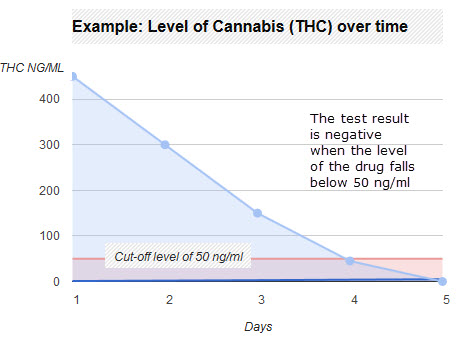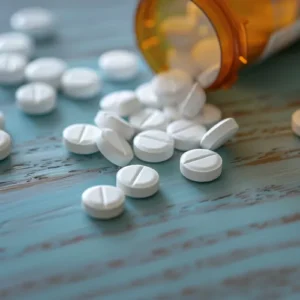An important factor that must be considered when carrying out drug testing is the application of cut-off levels. All drug screens have a cut off level which is internationally decided by by SAMHSA (Substance Abuse and Mental Health Services Administration). In this article we look at the Drug Test Cut Off Levels for various commonly used drugs of abuse.
How Are Drug Test Cut Off Levels Shown?
Drug testing cut-off levels are normally expressed as ng/mL (which means nanograms per millilitre) The cut-off level of a drug test is the ng/mL measurement at which a sample is deemed to be either a positive or a negative test result.
Each drug of abuse has it’s own defined drug concentration level which is the cut-off that has been chosen to minimise the chance of false positive results. An important thing to note here is that a negative drug test result does not necessarily mean that the urine sample is drug free, it just means that the concentration of the drug is lower than the defined cut-off.
When a drug test result proves to be positive, this is only an indicator that drug is present in the sample. What the test cannot tell you is how much of the drug was used or taken and if this had any correlation with the impairment of the individual at the time. It should also be remembered, that this kind of test is a screening tool and another testing method should be used to obtain a definite positive result.
It is important to note that the cut-off levels for drug testing can vary depending on the type of drug test being used. For example, a hair follicle drug test may have a different cut-off level compared to a urine drug test. Additionally, different industries and companies may have their own specific cut-off levels based on their individual policies and regulations.
It is crucial for employers and testing agencies to understand the cut-off levels for each type of drug test in order to accurately interpret the results and make informed decisions. Misinterpreting results or using incorrect cut-off levels can lead to false positives or false negatives, which can have serious consequences.
Overall, drug testing cut-off levels play a crucial role in ensuring accurate and reliable drug testing results, but they must be used properly and in conjunction with other testing methods and tools to make informed decisions about drug use and impairment.
Drug Test Cut Off Level For Cannabis
We have a dedicated article on the Drug Test Cut Off Levels For Cannabis, which is an informative read if you need more info on the subject. You may also want to read our blog post on how long cannabis is detectable in the body.
In general, the cut off levels for Cannabis are as follows:
Urine Drug Testing – 50 ng/mL
Saliva Drug Testing – 12 ng/mL
UK Drug Testing Cut Off for Driving – 2µg/L

Drug Test Cut Off Levels for Cocaine
Please refer to our article on Drug Test Cut-off Levels for Cocaine for detailed information on this subject. You should be aware that a urine drug test for cocaine will detect both Cocaine and its metabolite benzoylecgonine. How long cocaine is detectable in the body will be determined by past usage and the type of drug test taken.
In general, the cut off levels for Cocaine are as follows:
Urine Drug Testing – 300 ng/mL
Saliva Drug Testing – 20 ng/mL
UK Drug Testing Cut Off for Driving – 10µg/L
Drug Test Cut Off Levels for Opiates
An opiates drug test will screen for a variety of substances, which include Heroin and Morphine. Our blog post can offer you more information on Drug Test Cut Off Levels for Opiates. You may also refer to our article on how long heroin is detectable in the body?
In general, the cut off levels for Opiates are as follows:
Urine Drug Testing – 300 ng/mL
Saliva Drug Testing – 40 ng/mL
UK Drug Testing Cut Off for Driving – 5µg/L
Drug Test Cut Off Levels for Benzodiazepines
Benzodiazepines are part of a group of drugs known as depressants. Clonazepam, Diazepam, Flunitrazepam, Oxazepam, Rohypnol and Temazepam will all be picked up by a benzodiazepines drug test.
Detail information on drug test cut off levels for benzodiazepines can be found in our blog post. Similarly, if you require information on how long benzodiazepines can stay in your system.
In general, the cut off levels for Benzos are as follows:
Urine Drug Testing – 300 ng/mL
Saliva Drug Testing – 10 ng/mL
UK Drug Testing Cut Off for Driving – 50µg/L
Cut-Off Levels – what’s the big deal?
Drug testing cut-off levels play a crucial role in ensuring accurate and reliable results. When you take a drug test, the concentration of the drug or its metabolites in your sample is compared to the established cut-off level. If the concentration exceeds the cut-off, it’s considered a positive result. However, if it falls below the cut-off, it’s deemed negative. Simple, huh? Or maybe not ….
It’s important to understand that a negative result doesn’t necessarily mean you’re completely drug-free. It simply means the drug concentration was below the defined threshold. This is why cut-off levels are carefully determined to minimise false positives while still detecting legitimate drug use.
False Positives and False Negatives
When it comes to false positives. And to false negative, it’s all about balance. At Zoom Testing we are often asked for advice on this tricky area.
Setting appropriate cut-off levels helps reduce the risk of false positives, where someone is wrongly identified as using drugs when they haven’t. False positives can have serious consequences, like losing a job or facing legal issues. That’s why cut-off levels are designed to be high enough to avoid detecting trace amounts from incidental exposure.
On the flip side, cut-off levels that are too high could lead to false negatives, where drug use goes undetected. Finding the right balance is essential for accurate testing.
Factors Influencing Cut-Off Levels
You might wonder what factors affect cut-off levels? Lots of things do. Take hair tests as an example; they need smaller cut-offs than pee tests since hair holds onto drug bits longer. Additionally, some industries or organisations may set their own cut-off levels based on specific policies or safety concerns. For instance, transportation companies might have stricter cut-offs for safety-sensitive positions like truck drivers or pilots. Let us know if you have any special requirements when it comes to cut off level and we can advise. Just drop us an email.
Legal and Regulatory Considerations
Most times, local laws or set rules guide these cut-off points. In the US, agencies like SAMHSA steer the rules for workplace drug checks. They give cut-off advice for drugs after lots of study and looking at the numbers. The UK uses similar guidelines for drug tests. Here at Zoom Testing, our checks stick to SAMHSA’s cut-off advice. All of our drug tests at Zoom Testing meet SAMHSA cut off requirements, unless stated otherwise.
Laboratories conducting drug tests for federally-mandated programs must adhere to these guidelines to maintain certification and ensure legal defensibility of their results.
Continuous Evaluation and Updates
As new drugs emerge, including the evolution of many former legal highs, testing methods evolve and cut-off levels are regularly re-evaluated and updated. Drug testing experts look at factors like potential cross-reactivity with other substances, the prevalence of drug use, and the latest scientific research.
By continuously refining cut-off levels, drug testing programs can maintain their effectiveness and accuracy, providing reliable information to employers, law enforcement agencies, and other stakeholders.
Photo by Anthony Cunningham for Zoom Testing
Zoom Testing is a leading UK drug testing company and a supplier of Drug Test Kits.





